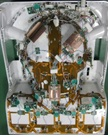1289
A Novel PET Optimized Head Neck Coil for 3T Simultaneous MRPET System1GE Healthcare, Aurora, OH, United States, 2GE Healthcare, Waukesha, WI, United States
Synopsis
A PET optimized 21- Element Head Neck coil is described for acquiring high-sensitivity MR (Magnetic Resonance) images and good quality PET images of head/neck, carotids, and cervical spine at 3 Tesla simultaneous MR/PET system. This Head Neck prototype2 coil has been optimized to minimize the interference with -ray detection of the PET without sacrificing MR image quality. In this study, we developed a foam technology to replace the rigid plastic coil formers, optimized arrangement of components (internal cables, internal cable baluns, feed boards and decoupling boards) and introduced new mechanical fastener and snap features.
INTRODUCTION
The integration of magnetic resonance imaging (MR) and positron emission tomography (PET) can provide useful information for clinical diagnosis and investigation. Integrated MR/PET scanner simultaneously delivers excellent soft tissue contrast, high spatial and temporal resolution of anatomic and metabolic information. While the RF surface coil deign today is well established in MRI [1], its use in an integrated MR/PET is technically challenging. The RF coil that is placed on the patient’s body to have optimal MR performance is at the same time in the FOV of PET and attenuates positrons resulting in artifacts or poor-quality PET images. This is especially a concern for whole body imaging where the patient is setup once and a full body scan is conducted. Hence having a low PET attenuation is critical to good quality PET images during simultaneous MR/PET acquisition. This has previously not been a design consideration for Surface coils. In this study, we designed a novel 3T, 21-element foam technology base Head Neck RF coil for head/neck, carotids and cervical spine imaging to minimize the interference with gamma- ray detection from PET detectors while maintaining MR performance.METHODS
The major criteria for the optimization of a PET-compatible 3T 21 Channel Head Neck coil are 1) to replace the rigid coil covers with the novel plastic-free foam assemblies 2) to arrange the coil components to avoid attenuating material on the superior side of the head, 3) to design PET transparent components (cable, cable balun, decoupling and feed boards). Evaluations of the PET performance on the GE GEM MR Head Neck coil, MR/PET prototype coils and coil materials were completed. PET performance [2] improvements were measured by calculating sensitivity loss for a 10 min period over three 15cm regions that covered the entire coil length in the S-I direction. Sensitivity loss is defined as the difference between coincidences counts recorded with and without the RF coil as a percentage of the counts recorded without the coil. Scans were acquired with GE’s Discovery PET/CT 600 scanner. A cylindrical phantom of 21.2cm diameter and 28.98cm height filled with 68Ge was used to calculate the average sensitivity loss over each bed. We found the most PET sensitivity loss caused by the head neck coil plastic covers. The MR/PET Head Neck prototype2 coil was built on a MR compatible ~1cm foam base. Another 5mm foam stack up was used for UL94-V0 compliance. A medical-grade foil was used as the coil cover sleeve for biocompatibility and a watertight seal (Figure 2). The 21-ch micro coaxial output cable was replaced by a new flat cable with a new cable balun design and the feed board and decoupler components of were optimized for PET transparency (Figure 1). Each element was tuned to 127.73MHz and matched to 50 ohms. Nearest neighboring elements were decoupled by overlapping; next nearest neighbor and more distant elements were decoupled by exceptionally low noise preamplifiers tolerant of a wide range of loop loading conditions. The average unloaded and loaded Q ratio of was ~3. MR performance was measured by comparing the SNR (Signal and Noise Ratio) to the GE GEM MR Head Neck coil. Axial images of a 10cm radius spherical phantom filled with non-loading solution were acquired from both coils on a 3T/70 cm G.E. Architect scanner (Spin echo, TR/TE=500/20msec, matrix=256x256, FOV=45cm, st=5mm, Nav=1). SNR was computed by acquiring separate signal and noise images and dividing the signal mean by the noise standard deviation over circular ROIs.RESULTS
Table 1 shows sensitivity loss of the prototype2 coil as compared to G.E. GEM MR Head Neck coil. We observed a 71.28%, 75.39% and 75.78% improvement in sensitivity loss in each of the three beds respectively. Table 2 shows the signal and noise ratio acquired and measurement ROIs for the non-loading spherical phantom for the GEM MR Head Neck and the MR/PET Head neck prototype2 coil. The average SNR for the MR/PET Head Neck prototype2 coil is ~3.2% better than the GEM Head Neck coil.CONCLUSION
The 3T 21-element PET optimized Head Neck coil shows significant improvement on sensitivity loss with good MR performance. This coil is ideally suited for simultaneous MR/PET head, neck, carotids and cervical spine imaging. The results show that reconsidering coil design for PET transparency can yield considerable benefits. These developments can improve MR/PET image quality and reduce artifacts induced by RF coils. Future work will include scanning human volunteers to qualify the improvements.Acknowledgements
We also thank Saban Kurucay, Dan Chirayath, Pei Ho and Mohamed El-Demerdash from GE Healthcare for their continued support.References
1. Roemer, P.B. et al. 1990, MRM 16:2, 192-225.
2. G Delso et al. 2010 Phys. Med. Biol. 55, 4361-4374.
Figures



Table1: PET performance results on various prototypes

Table 2: SNR comparison between MR/PET Head Neck coil and MR GEM Head Neck Coil